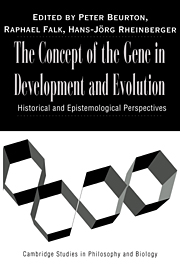Book contents
- Frontmatter
- Contents
- Introduction
- List of Authors
- PART ONE GENES AND TRAITS
- 1 The Dissolution of Protein Coding Genes in Molecular Biology
- 2 The Differential Concept of the Gene: Past and Present
- 3 Gene Concepts and Genetic Concepts
- PART TWO EXTRACTING THE UNITS OF HEREDITY
- PART THREE GENETIC PROGRAMS AND DEVELOPMENTAL GENES
- PART FOUR CONCEPTUAL PERSPECTIVES
- FINAL REVIEW
- Glossary
- Index
1 - The Dissolution of Protein Coding Genes in Molecular Biology
from PART ONE - GENES AND TRAITS
Published online by Cambridge University Press: 12 January 2010
- Frontmatter
- Contents
- Introduction
- List of Authors
- PART ONE GENES AND TRAITS
- 1 The Dissolution of Protein Coding Genes in Molecular Biology
- 2 The Differential Concept of the Gene: Past and Present
- 3 Gene Concepts and Genetic Concepts
- PART TWO EXTRACTING THE UNITS OF HEREDITY
- PART THREE GENETIC PROGRAMS AND DEVELOPMENTAL GENES
- PART FOUR CONCEPTUAL PERSPECTIVES
- FINAL REVIEW
- Glossary
- Index
Summary
ABSTRACT
The consensus gene, a methodological outcome of the rapid growth in molecular biology, is a collection of flexibly applied parameters derived from features of well-characterized genes. Broad flexibility unites research programs under one umbrella and simultaneously promotes the false impression that the molecular gene concept is an internally coherent universal. This suggests limitations for genomic interpretations of information content in biological systems and for explanatory models that use genes as a manipulative. Genomic referencing, the development of systemic relationships among DNA domains, will more fully interconnect molecular genetics to biology than the molecular gene alone. Advances in understanding regulation and expression of DNA and the current interest in large-scale sequencing will necessarily supervene on much of the attention currently bestowed on molecular genes.
INTRODUCTION
The gene concept, long regarded as a unit of inheritance, undergoes continuous transformation to accommodate novel structures and modes of action. A little more than a decade after the rediscovery of Mendel's work in 1900, new analytical strategies emerged for mapping genes as loci in a linear array on a chromosome. During the 1940s, the one-gene — one-enzyme model revealed that genes act to generate specific cellular products, a precursor to the science of molecular genetics. In the years that followed, the gene underwent further change. First, the double helix model of DNA made famous by Watson and Crick revealed the physical structure for particulate inheritance. Later efforts clarified the biochemistry of gene expression. Today, in the era of genomic sequencing and intense effort to identify sites of expression, the declared goal is to search for genes, entities assumed to have physical integrity.
- Type
- Chapter
- Information
- The Concept of the Gene in Development and EvolutionHistorical and Epistemological Perspectives, pp. 3 - 25Publisher: Cambridge University PressPrint publication year: 2000
- 43
- Cited by



